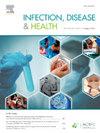Staphylococcus aureus infections in a highly complex clinic in Colombia. A longitudinal retrospective observational study
IF 2
Q2 PUBLIC, ENVIRONMENTAL & OCCUPATIONAL HEALTH
引用次数: 0
Abstract
Background
Antimicrobial resistance is a public health problem. Methicillin-resistant Staphylococcus aureus (MRSA) is one of the microorganisms most responsible for illness and death. The aim was to characterize the infections caused by S. aureus and to determine the factors associated with in-hospital mortality in patients treated in a highly complex clinic in Colombia.
Methods
This was a longitudinal retrospective observational study of patients with culture-confirmed S. aureus infections who received hospital care between 2018 and 2023. Follow-up was carried out until the patients died or were discharged from the clinic. Descriptive, bivariate and multivariate analysis was performed.
Results
A total of 361 patients were included; 62.6 % were men, and the mean age was 49.2 years. Most patients were diagnosed with skin and soft tissue infections (51.0 %) and bacteremia (25.5 %). The most used antibiotics were clindamycin (53.5 %) and vancomycin (42.7 %). A total of 46.3 % had MRSA infections and 25.8 % were resistant to clindamycin, 37.7 % of the patients received care in the intensive care unit, 33.2 % had sepsis, 19.1 % required invasive mechanical ventilation, and 13.9 % died. Higher Charlson comorbidity index (aOR:1.45; 95%CI:1.04–2.02), higher Pitt Bacteremia Score (aOR:1,72; 95%CI:1.21–2.46) and bacteremia (aOR:5.30; 95%CI:1.44–19.41) increased the probability of death. Those who were empirically managed with antibiotics that had coverage for MRSA (aOR:0.03; 95%CI:0.00–0.24) and higher levels of hemoglobin (aOR:0.75; 95%CI:0.65–0.87) had a lower risk of death.
Conclusion
MRSA infections are frequent, with significant resistance to clindamycin. The identification of variables associated with a higher risk of dying may be useful for establishing protocols in hospitals that reduce this outcome.
哥伦比亚一家高度复杂诊所的金黄色葡萄球菌感染。一项纵向回顾性观察研究。
背景:抗菌素耐药性是一个公共卫生问题。耐甲氧西林金黄色葡萄球菌(MRSA)是最负责疾病和死亡的微生物之一。目的是确定金黄色葡萄球菌引起的感染的特征,并确定与在哥伦比亚一家高度复杂的诊所接受治疗的患者住院死亡率相关的因素。方法:这是一项纵向回顾性观察研究,研究对象是2018年至2023年间接受医院治疗的培养确诊金黄色葡萄球菌感染患者。随访至患者死亡或出院。进行了描述性、双变量和多变量分析。结果:共纳入361例患者;62.6%为男性,平均年龄49.2岁。大多数患者被诊断为皮肤和软组织感染(51.0%)和菌血症(25.5%)。使用最多的抗生素是克林霉素(53.5%)和万古霉素(42.7%)。46.3%的患者有MRSA感染,25.8%的患者对克林霉素有耐药性,37.7%的患者在重症监护病房接受治疗,33.2%的患者有脓毒症,19.1%的患者需要有创机械通气,13.9%的患者死亡。高Charlson合并症指数(aOR:1.45;95%CI:1.04-2.02),较高的皮特菌血症评分(aOR: 1.72;95%CI:1.21-2.46)和菌血症(aOR:5.30;95%CI:1.44-19.41)增加了死亡概率。那些经验性地使用具有MRSA覆盖率的抗生素进行管理的人(aOR:0.03;95%CI:0.00-0.24)和更高水平的血红蛋白(aOR:0.75;95%CI:0.65-0.87)死亡风险较低。结论:MRSA感染较为常见,且对克林霉素有明显耐药性。识别与较高死亡风险相关的变量可能有助于在医院建立减少这一结果的方案。
本文章由计算机程序翻译,如有差异,请以英文原文为准。
求助全文
约1分钟内获得全文
求助全文
来源期刊

Infection Disease & Health
PUBLIC, ENVIRONMENTAL & OCCUPATIONAL HEALTH-
CiteScore
5.70
自引率
5.70%
发文量
40
审稿时长
20 days
期刊介绍:
The journal aims to be a platform for the publication and dissemination of knowledge in the area of infection and disease causing infection in humans. The journal is quarterly and publishes research, reviews, concise communications, commentary and other articles concerned with infection and disease affecting the health of an individual, organisation or population. The original and important articles in the journal investigate, report or discuss infection prevention and control; clinical, social, epidemiological or public health aspects of infectious disease; policy and planning for the control of infections; zoonoses; and vaccination related to disease in human health. Infection, Disease & Health provides a platform for the publication and dissemination of original knowledge at the nexus of the areas infection, Disease and health in a One Health context. One Health recognizes that the health of people is connected to the health of animals and the environment. One Health encourages and advances the collaborative efforts of multiple disciplines-working locally, nationally, and globally-to achieve the best health for people, animals, and our environment. This approach is fundamental because 6 out of every 10 infectious diseases in humans are zoonotic, or spread from animals. We would be expected to report or discuss infection prevention and control; clinical, social, epidemiological or public health aspects of infectious disease; policy and planning for the control of infections; zoonosis; and vaccination related to disease in human health. The Journal seeks to bring together knowledge from all specialties involved in infection research and clinical practice, and present the best work in this ever-changing field. The audience of the journal includes researchers, clinicians, health workers and public policy professionals concerned with infection, disease and health.
 求助内容:
求助内容: 应助结果提醒方式:
应助结果提醒方式:


